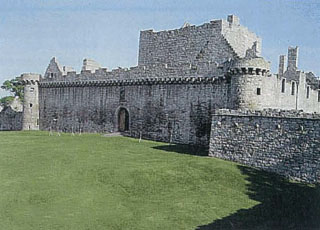
[caption id="LettersfromOurReaders_img1" align="aligncenter" width="320"]

DESPERATELY SEEKING CRAIGMILLAR
I HAVE BEEN A SUBSCRIBER to your magazine for the last three years, and I enjoy every issue.
In the September 2003 issue, “Britain Under the Caesars,” there was an article on page 12 called “England and Scotland United.” In that small article Craigmillar Castle was mentioned. During World War II I was in the Women’s Army Corps Signal Corps, and we did our basic signal training in Edinburgh in a large building that we were told was called Craigmillars. We were told it was once a boarding school and that it had a ghost.
I have been to Edinburgh twice since I was stationed there in 1942 or 1943, but no one could give me any information about a building that matched my description. All I could remember was that it was very near Arthur’s Seat, and it was called Craigmillars. It did not look like the castle I was able to find on the Internet.
I would really like to know what happened to that building and why no one can remember it. I would appreciate any information you could give. I am beginning to think I imagined that whole section of my period in the service.
Ruby E. Murray
Ocala, Florida
EDITOR’S NOTE: In some aspects, the few particulars mentioned above do indeed seem to describe Craigmillar Castle, located just south-east of central Edinburgh. The castle boasts a fascinating history in its own right. Built in the 14th century, it became the scene of several dark and dirty deeds—just the kind of history that one might reasonably expect would result in a resident ghost or two. James II’s son, the Earl of Mar, supposedly bled to death in the castle in 1477, and Mary, Queen of Scots is said to have come to Craigmillar Castle to plot the murder of Lord Darnley.
And sure enough, there does seem to be a ghost associated with the castle, more or less. It’s not your typical spook, though. In this case, it’s a horse. According to legend, after James IV, a former resident of the castle, died in battle at Flodden in 1513, his black horse began to reappear now and then at the castle.
And finally, the top of the Tower House provides some wonderful views of Edinburgh, and Arthur’s Seat might well leave a lasting impression.
All in all, though, it seems unlikely that the Signal Corps conducted any training at Craigmillar Castle during the war. It lay in ruins, overgrown, from the 18th century until 1946, when it passed into the care of Historic Scotland, which maintains the historic site today.
Memories can be imprecise, and perhaps the name that Ms Murray recalls from her days in the service was not that of the building, but of the local residential development of Cragmillar that took its name from the castle. The neighborhood dates from the 1920s and it could be that a local boarding school was indeed commandeered, as were so many public buildings, for use by the military. In fact, Sir Arthur Conan Doyle, the creator of the Sherlock Holmes stories, attended a boarding school in the general vicinity and the Craigmillar Park Association is currently engaged in efforts to help save from demolition the nearby house in which he also lived.
Perhaps one of our readers can assist Ms. Murray with some concrete information, or confirm whether or not our speculation is on target.
CAN’T GET ENOUGH OF ROMAN BRITAIN
I HAVE TO TELL YOU how much I am enjoying the September 2003 issue of BRITISH HERITAGE. I have been to England 8 times and loved every minute of my time there. I am especially interested in evidence of Roman life. I have been to the Wall at Housesteads and and the remains of a Roman road way out in Yorkshire, as well as many other Roman sites.
Throughout the years I have loved Mary Sutcliff’s books, several of which tell of Roman times. The stories are good and the details help to bring it all alive. I am 90 years old and probably will not get to England again, but I do enjoy your magazine. Thank you.
Rebecca Mullen
Wildwood, New Jersey
EDITOR’S NOTE: We continue to receive very kind letters about our recent issue, “Britain Under the Caesars.” Clearly, the subject is one that a great many of our readers find of great interest. Always eager to indulge the tastes of our audience, we have recently commissioned another feature article with a Roman theme. The article will take a close look at the artists who created Roman Britain’s greatest masterpieces of mosaic flooring, and we hope to publish it in the not-too-distant future.
MAJESTIC
WHILE ON A TOUR OF BRITAIN in 1997 our bus passed through the town of Tetbury, Gloucestershire. The light-grey limestone row shops looked so majestic and refined. I’m curious about their approximate age.
Daniel Drzewiecki
Toledo, Ohio
EDITOR’s NOTE: Tetbury, of course, is only one of many such town in the Cotswolds district of England, which spans the region between Banbury and Bath. The distinctive limestone underlying the area is a primary local building material, which appears honey-coloured when new and weathers to a rather dignified shade of grey over time.
The Cotswolds is one of the most popular rural destinations for tourists, and Tetbury is among the more frequently visited towns. Many of the buildings in Tetford, and throughout the region, date from the 17th and 18th centuries, including the town hall (1655) and church (1778). Several wool merchant’s houses remain much as they looked 300 years ago.





Comments